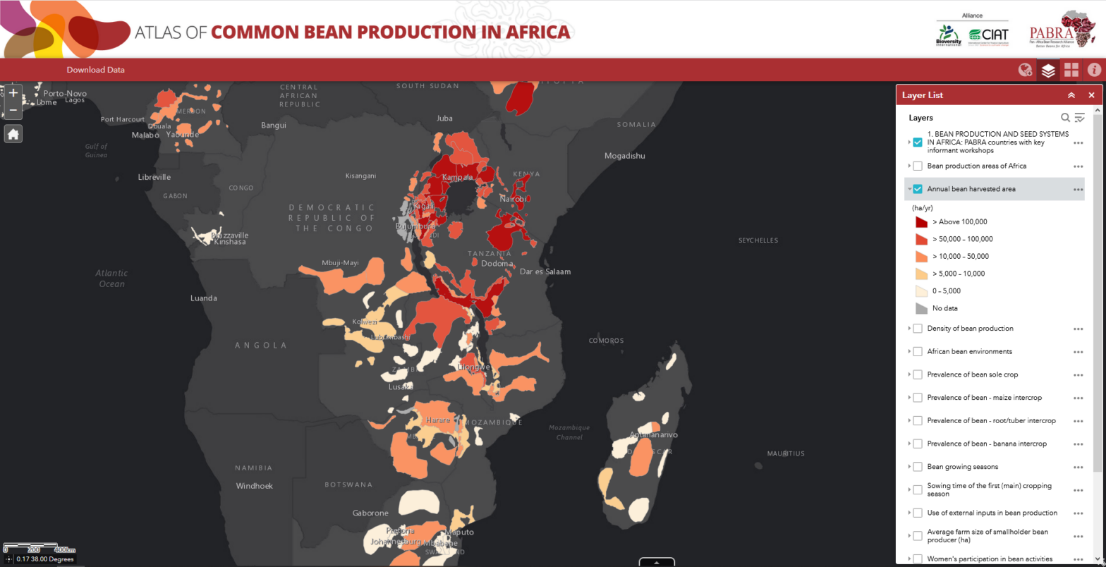By Rachel Muthoni Andriatsitohaina, Sean Mattson, Patricia Onyango, Owen Kimani, Elliot Gee, Andrew Farrow, Robin Buruchara and Jean Claude Rubyogo
The digital atlas models changes in suitability for bean production in Africa over the next ten to twenty years and discovers that temperature is more important in determining beans distribution than rainfall. Yet lack of soil moisture is the most widespread climatic constraint.
Temperature increase could reduce bean production in future
The Bean Atlas 2.0 by the Pan-Africa Bean Research Alliance (PABRA) maps climatic projections that by 2030 and 2050, designated areas suitable for bean production will diminish significantly as a result of climate variability, specifically high temperatures and drought. Bean production may have to shift to higher elevation zones such as the Ethiopian highlands,south Kivu in DRC, southern highlands of Tanzania etc should the conditions further deteriorate.
The Atlas illustrates suitable areas for bean growing in twenty years, and explores possible actions to mitigate this outcome. Using the Bean Corridors approach, a positive disruption in the bean value chains is envisioned, best mitigating actions are presented for improving the quantity and quality of beans grown.
It provides adaptation methods that smallholder farmers, extension systems and researchers can implement to deal with the ever changing climate. For instance, researchers tracked the release and adoption of improved bean varieties, for example, varieties bred specifically to endure drought tolerance. Similarly, the Atlas presents practices that allow smallholder farmers to cope with climate extremes such as intercropping or implementing agroforestry systems.
Launching the second edition Bean Atlas
This second edition of the Bean Atlas is a follow-up of Wortmann and Kirkby’s first edition of the common bean Atlas in 1998. A collaborative effort between PABRA partners, scientists from the Alliance of Bioversity International and CIAT, national programs, and specialists in various universities in Africa, the Atlas is a popular one-stop reference document for information about beans.
Since the first edition of the Bean Atlas, in 1998, PABRA’s extensive bean research network stretches across Africa, including West Africa which was missing in the first edition.
This second Atlas integrates new work on nutrition and markets, new constraints to bean production including the climate crisis, while exploring broader seed system impacts, new varieties released and the Bean Corridor concept developed by PABRA in collaboration with various public and private partners, to link demand with market research. This digital edition expands on the printed version to allow for dynamic presentation and real-time bean research updates occuring across the continent.
The new Atlas contains information and data about bean research in Eastern, Southern and Western Africa and covers four additional topics not in the previous edition: bean seed systems; current and future climate suitability for beans; and post-harvest storage and bean research and development. The Atlas covers data from 176 bean production areas.
Built using the Delphi method of consensus building, researchers acquired data from more than 350 expert contributors in 23 bean-producing countries across sub-Saharan Africa, developing a protocol to ensure consistency across countries. Data on harvested area and production and sub-national statistics has been sourced from the United Nations Food and Agriculture Organization. High-resolution spatial data on climate, soils and elevation has been refined and updated to reflect existing bean environments in Africa. To assess the impacts of climate change, the MAXENT model was used to compare current and future bean suitability in 2030 and 2050.
Reflecting on the Atlas development process
Using the Delphi method, data was collected and collated in a more timely and cost-effective manner, covering a wider geographic area in comparison to previous methods such as surveys. Workshops united a broad cross-section of experts from production, private industries and local partners, to ensure the latest available data and accuracy, especially higher resolution data on bean environments and bean harvested areas.
In instances where workshops could not be held, notably in the Central African Republic, Angola, and South Sudan, and North Tanzania, noticeable spatial data is missing. Some countries that recently joined the PABRA network such as Mali, Benin and Ivory Coast are not covered in this version. The Atlas covers a broad range of thematic topics and, in the future, current growth in bean markets will be covered extensively.
A note to investors
The bean crop in Africa has transformed from a mere subsistence food security crop for the household, to a high-value, highly nutritious food crop for income generation and improved livelihoods. This is the result of consistent, deliberate research work spanning decades.
Since 2017, PABRA has aligned research to form the Bean Corridor approach, which channels investment in improved bean production through its platform. The Bean Corridor builds on research and investment in three major hubs: the consumption hub, where we understand the demand for specific varieties and types of bean; to the production hub where those bean types are produced, through to the consumption hub where beans are bought by consumers.
The Second Edition of the Bean Atlas provides investors with a clear understanding of gaps in the bean-value chain, and where investments can make the most impact for results. It also outlines production constraints, how to overcome them, key diseases and pests, and variety suitability for specific areas. Those interested in retail will find detailed information about the demand for specific bean types and bean markets. The digital map will offer unique updates to address new opportunities and information requests, in response to investment in the platform.
The Bean Atlas project was a major undertaking, apparent from the evidence and insights generated. Any project of this size necessarily involves a large team effort. We are grateful to leaders and experts from 23 countries in Africa, as well as the OneCgiar and PABRA specialists, who willingly provided data and expert knowledge. Their detailed field knowledge was the main source of data for this project. To get the full webinar of the launch of the Bean Atlas 2.0, click the following link
To get the Bean Atlas Version 2.0 click on the following link https://www.pabra-africa.org/the-bean-atlas/

